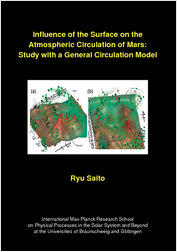Influence of the surface on the atmospheric circulation of Mars
study with a general circulation model
| dc.contributor.author | Saito, Ryu | |
| dc.date.accessioned | 2010-10-12T18:23:11Z | |
| dc.date.available | 2010-10-12T18:23:11Z | |
| dc.date.issued | 2007 | |
| dc.identifier.uri | http://hdl.handle.net/11858/00-1735-0000-0001-30C8-4 | |
| dc.description.abstract | Unlike on Earth where 3/4 of the surface is covered by oceans, the Martian surface has rougher topography with greater magnitudes of mountains and valleys. The Martian atmosphere is less dense compared to the terrestrial one. The planetary boundary layer is significantly shallower on Mars than on Earth. These differences indicate that the Martian atmosphere should be very sensitive to the forcing from below. The major mechanism which provides vertical coupling are atmospheric waves generated in the lower atmosphere near the surface. These waves transport the momentum, energy, and heat away from places of their generation in the lower atmosphere. Propagating upward the wave disturbances grow in amplitude, and ultimately break or dissipate. They release the wave energy and momentum to the zonal mean circulation, and thus affect the global transport in the atmosphere of Mars. The main task of this work is to study various physical phenomena which take place in the atmosphere near the surface with an emphasis on the mechanisms of wave generation ... | |
| dc.format.extent | 83 S. | |
| dc.format.mimetype | application/pdf | |
| dc.language.iso | eng | |
| dc.publisher | Univ. Zugl.: Braunschweig | |
| dc.rights.uri | http://e-docs.geo-leo.de/rights | |
| dc.subject.ddc | 523 | |
| dc.subject.gok | TGG 565 | |
| dc.title | Influence of the surface on the atmospheric circulation of Mars | |
| dc.title.alternative | study with a general circulation model | |
| dc.type | monograph | |
| dc.subject.gokverbal | Marsatmosphäre {Astronomie} | |
| dc.identifier.doi | 10.23689/fidgeo-67 | |
| dc.identifier.ppn | 600972380 | |
| dc.identifier.urn | urn:nbn:de:gbv:084-13395 | |
| dc.type.version | publishedVersion | |
| dc.relation.collection | Astronomie, Astrophysik, Weltraumforschung | |
| dc.description.type | thesis |


